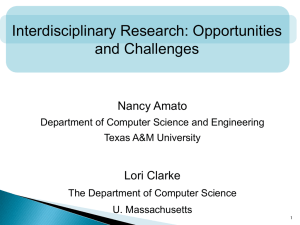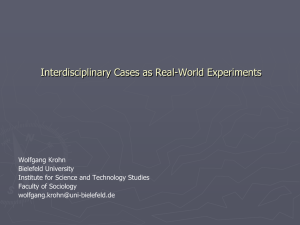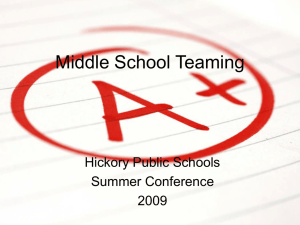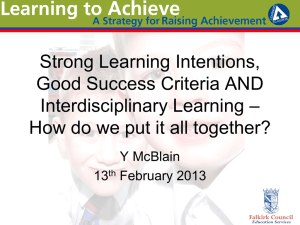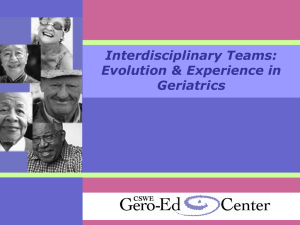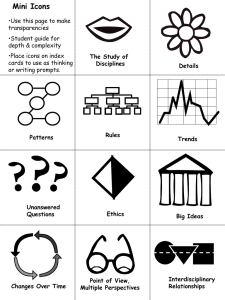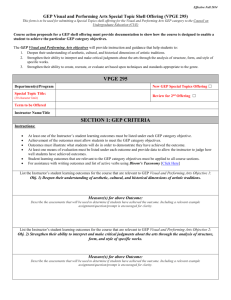Interdisciplinary Studies in the Integration Level of the GEP
advertisement
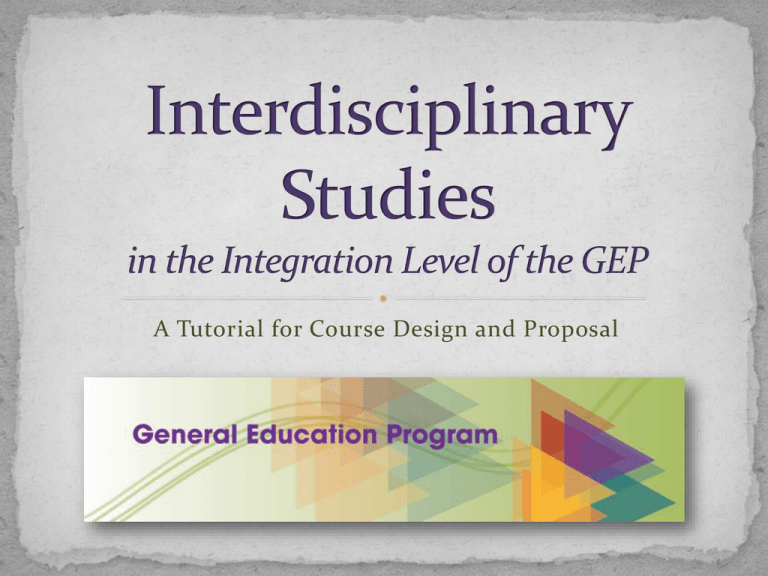
A Tutorial for Course Design and Proposal Introduction to Interdisciplinary Studies……….....................…... Slides 3-5 Defining Interdisciplinary Studies……………………………………..……......... 6-8 Step 1: Interdisciplinary Studies and the GEP……………..……………......… 9-12 Step 2: Course Status and Method........................................................ 13 Step 3: Locating and Opening the Form……………..………….………......…. 14-15 Step 4: Basic Information and an Example of a Completed Form.….. 16-17 Step 5: Designing Learning Outcomes…..……………………………….………. 18-20 Step 6: Explanation of Alignment…………………………………………………... 22-26 Step 7: Interdisciplinary Nature……………………………………………….……… 28-31 Step 8: Who, How, and What………………………………………………….………. 33 8a: Discipline-Specific Skills…………………………………………….……….. 34 8b: Knowledge Requirements and Examples…………….…….………… 35-38 8c and 8d: Assessing Learning and Example Assignment……….. 39 Step 10: Final Steps…………………………………………………………………..……… 40 Appendix 1: Learning Outcome Verbs…………………………………………….. 42 You have chosen to view this tutorial because you are about to submit a GEP (General Education Program) Application Form for Interdisciplinary Studies. Thank you! This tutorial has been designed to walk you through the proposal process for an Interdisciplinary Studies course within the Integrative Level of the GEP. Therefore, understanding that interdisciplinary has multiple definitions, how it is defined within our GEP is important to understand. This guide will help with that understanding and much more. There may be some steps of the tutorial that are familiar and others that may be new to you. This design is to accommodate all levels of understanding. Enjoy the process! You are contributing to an important need and an important part of the learning experience for all students! It is always a good idea to start off any learning experience with the “big idea”! Regarding Interdisciplinary Studies, who other than Parker Palmer and Arthur Zajonc to give us this important perspective? “We need a way of thinking about community in higher education that relates it to the central mission of the academy—the generation and transmission of knowledge.” “…higher education should reorganize curricula toward a more integrated vision of the world, offer more interdisciplinary studies, and do more ethical and valueoriented work.” Palmer, Parker J. and Zajonc, Arthur from their book, The Heart of Higher Education . 2010. With that inspiration, you are here to design and propose an Interdisciplinary Studies course for the GEP! Let’s get started! One basic concept with the design of any GEP course will be the concept of learning outcomes. So, let’s get started with using some for this tutorial: Upon the completion of the directed activities in this tutorial, you will be able to: • • • • complete a GEP Application Form for an Interdisciplinary Studies Course define Interdisciplinary Studies and its application to the GEP design measurable learning outcomes for your course align your course learning outcomes with the related discipline category learning outcomes within the GEP Investigation Level • explain the interdisciplinary nature of your course • explain how you (and your teaching colleague if you are team teaching) meet the knowledge requirements for this interdisciplinary course • relate specific skills and learning assessments to your Interdisciplinary Studies course Take note of this structure: “Upon the completion of this tutorial course, you will be able to” along with the action verbs complete, define, design, submit, and so on. We will use this language later! Forward to Slide 18 (Step 5: Designing Learning Outcomes) Defining Interdisciplinary Studies The following two definitions will further define Interdisciplinary Studies within the context of the GEP. These definitions will be useful as you move to the Interdisciplinary Nature and Discipline-specific Skills sections of the proposal form. Take a moment to study the two definitions on the next two slides. Note how the term integrate (and its derivatives) applies to the creation of a new problem or perspective. “Interdisciplinary studies may be defined as a process of answering a question, solving a problem, or addressing a topic that is too broad or complex to be dealt with adequately by a single discipline or profession . . . [It] draws on disciplinary perspectives and integrates their insights through construction of a more comprehensive perspective.” Julie Thompson Klein and William Newell from their book, Handbook of the Undergraduate Curriculum, 1997. Interdisciplinary shall be defined as “integrating content, data, methods, tools, concepts, and theories from two or more disciplines or bodies of specialized knowledge in order to advance fundamental understanding, answer questions, address complex issues and broad themes, and solve problems”. Julie Thompson Klein from her book, Creating Interdisciplinary Campus Cultures: A Model for Strength and Sustainability, 2010. Before we move to the next section on the proposal form Explanation of Alignment and subsequent sections, it will help to define Interdisciplinary Studies as it applies to the GEP. Interdisciplinary Studies within the GEP means something very specific. Therefore, for your proposal to be successful, it will be important to apply what is meant by disciplines and interdisciplinary within the GEP. Let’s first look at how disciplines are referred to within the context of the GEP. Go the next page and examine the GEP Diagram… After studying this diagram, go to the next page. Now that you have taken a look at the GEP Diagram, note the following: Interdisciplinary Studies in the GEP is on the Integration Level. The GEP Interdisciplinary Studies course draws on or integrates two discipline categories from the Investigation Level. Imagine the possibilities…here are a few: Now, using the diagram below, choose two discipline categories from the Investigation Level that apply to your course learning outcomes. You may may want to use the Investigation Level learning outcomes by clicking: here or reading pages 14-19 of the GEP booklet to decide which categories best apply or align with your course, and then returning to this tutorial. Before filling out the proposal form, consider these distinctions about your course: Course Status Is your course an existing course, interdisciplinary in design and nature, but simply not officially approved by the General Education Committee? Is your course an existing course that could be adjusted through the learning outcomes to fit the Interdisciplinary Studies category? Do you have an idea for an Interdisciplinary Studies course but have yet to design this course? Instructional Method Will you be the only instructor for this course or will you collaborate with another colleague outside your discipline and team-teach the course? Include your answers to these questions in your notes and let’s move on to Step 3: For both existing courses and any brand new course*, you will need to use the “GEP Interdisciplinary Studies Course Application Form” for Interdisciplinary Studies designation in the GEP. This form can be located on the General Education Program Resource Page: http://www.uwsp.edu/acadaff/Pages/GEPresources.aspx CLICK on the link above and proceed to the next page! *Note: For brand new courses, you will need to follow the appropriate procedures for submitting new courses to the University Curriculum Committee simultaneously with this process for Interdisciplinary Studies distinction in the GEP. You should now see a page that has the excerpt as posted below. 1. Locate on that page the “Phase II: Course Application Approval” 2. Then, locate the GEP Application Form Interdisciplinary Studies (save as…)”. 3. Then, click on it! 4. Proceed to the next page of this tutorial… Clicking on the “GEP Application Form Interdisciplinary Studies (save as…)” will download the form to your computer. Locate the downloaded form and save the blank form to your computer with a new name that is reflective of the department and course name. The Microsoft Word document has fillable fields and drop-down selections. Let’s take a look at a completed example along with a few things to keep in mind… Using Tori Jennings’ ANTH 339 IS course proposal, complete the same section on your form, with these guidelines: Only one home department is listed not two discipline departments. The contact person may be the Department or Division Head or the Instructor of the course. List all instructors if the course is team-taught. The Curriculum Code, Course Number, Title, and Description are listed exactly as in the catalogue. A PDF hyperlink is included for the syllabus. This is an existing course. While this course is not “cross-listed”, other courses such as IS-approved Political Science 389 and History 389 can be referenced in this way. This is the same course, offered as two sections. SAVE YOUR WORK and let’s move on to STEP 5… A learning outcome is a statement that describes what knowledge, skills, abilities, and/or dispositions you want your students to acquire as a result of a learning experience (or your course as a whole). Learning outcomes typically follow a standard schema, such as: Students can/will be able to… action verb... specific knowledge/ability/disposition that students will achieve. Return to Slide 5 if you’re sneakpreviewing this section. Let’s examine Tori Jennings' example from her IS course proposal: This is an exemplary set of learning outcomes! Note the use of “After taking this course, students will be able to:” phrase. Note the use of action verbs within each outcome: o “analyze” o “apply” o “recognize” But, there is more! o “explain” You can also review the learning-outcome language of this tutorial Now it is time to write your learning outcomes for your course! Enter your outcomes on the form space marked “Course Learning Outcomes”. Do this now with the following reminders and resources. Take your time before moving on to the next slide! Remember to include “Students will be able to – followed by an action verb – followed by specific knowledge, ability, and/or disposition that students will achieve. By using this language, the assessment process is doable because your outcomes become measureable! A common error when writing learning outcomes is the use of “students will understand” or “students will learn” or “students will know” rather than language that will describe what knowledge, ability, and/or disposition your students will acquire as a result of a learning experience in your course. As you work, you can refer to a list of Learning Outcome Verbs in Appendix 1 by clicking on: Let’s take a break! Now that you have completed the basic information on the proposal form, designed your course learning outcomes, and identified two discipline categories within the Investigation Level that best relate to your course, our next task is to explain how your course learning outcomes align with the GEP category learning outcomes in the Investigation Level. Let’s take a closer look your 2 chosen GEP/Investigation Level discipline categories and the respective learning outcomes: GEP Investigation Learning Outcomes Last slide viewed With your course learning outcomes and the Investigation-level discipline category outcomes as references, do the following: Integrate your course learning outcome language and the language in each discipline-based learning outcome from your chosen 2 disciplines in the Investigation Level to create explanations of alignment. Take note of Tori Jennings’ Explanation of Alignment from her ANTH 339 proposal on the next slide: Note: This example is from the previous IS Proposal form. Refer to content narrative as a model for your proposal with the updated form. Based on Tori’s ANTH 339 proposal example, note the following as guidelines for your proposal: The use of two discipline categories: Social Science and Historical Perspectives The format of two discipline categories, listed separately, with explanation-of-alignment statements The integration of language from the ANTH 339 course learning outcomes with the discipline-category learning outcomes. With this example as your model format and the previous guidelines, take some time now to complete your explanations-of-alignment statements. Enter your final statements onto the form in the space marked Explanation of Alignment. Now that you have read these definitions, let’s consider these questions: Does your course include learning experiences that integrates two or more disciplines, or is the course merely referencing two or more disciplines? With an integration of two or more disciplines, have you considered a concept, issue, question, or problem to be solved that offers students an opportunity to integrate two or more disciplines to reach a deeper understanding? Keep your notes from this reflection on the interdisciplinary nature of your course as we take a look at the learning outcomes for Interdisciplinary Studies in the GEP… Interdisciplinary Studies learning outcomes in the GEP: Identify an issue or question related to the interdisciplinary course(s), and describe what each discipline contributes to an understanding of that issue. Explain the benefits of being able to combine these contributions. Your explanation of the Interdisciplinary Nature of your course will combine your reflection on the previous questions concerning integration and deeper understanding with your reflection on what students will be able to do to demonstrate their understanding after experiencing your interdisciplinary course. Take some time to write your explanation of the interdisciplinary nature of your course. To help in your work, refer to the next two slides for examples of interdisciplinary-nature explanations from approved proposals. * Note: This example is from the previous IS Proposal form. Refer to content narrative as a model for your proposal with the updated form. * Note: This example is from the previous IS Proposal form. Refer to content narrative as a model for your proposal with the updated form. The next four sections of the proposal form deal with who will teach with details about qualifications within an interdisciplinary learning experience, with how discipline-specific skills are used and how student learning will be assessed, and what makes a sample assignment conducive to this way of learning. Discipline-specific skills Knowledge Requirements. How Student Learning will be assessed Example Assignment Let’s take one at a time! This section in your proposal is the “how”. That is, how will you use disciplinebased skills as tools within the course to enhance student learning? The point of this section is to explain what is unique about your course through an explanation of the use of discipline-specific teaching tools. While thinking through this section, reflect on what you will have your students do to demonstrate their learning in your course. Examples of teaching tools from other IS courses include: Holistic thinking is a tool for teaching critical thinking skills. (ANTH 339) Historical analysis of texts and various forms of representation… (ANTH 339) Policy analysis will include interpreting quantitative and qualitative data. (HIST 389) Discipline specific skills for aesthetics (Humanities): (WDMD 348) • Students will use both video lighting and composition • Video white balance in production and post-production • Focus and depth of field of video camera for best visualization • Sound capture that enhances enjoyment and usability With the integration of two (or more) disciplines into one course, teaching an interdisciplinary course requires unique training and knowledge. While being credentialed in a specific discipline certainly qualifies one to teach in one discipline, what are the knowledge requirements for teaching an interdisciplinary course? Responses to this part of the proposal will vary. While having a passing interest in one of the disciplines within a proposed course naturally would not be acceptable, the obvious acceptance of an instructor being fully credentialed or having two instructors, in the case of a team-taught course, credentialed respectively in the included disciplines is not the only way to be approved for this kind of instruction. Significant teaching, professional, and discipline-based-research experience instead of any credentials are just a few examples of what would be considered adequate knowledge requirements. As you consider your own explanation about knowledge requirements for this proposal, review the following examples of other colleagues narratives from their GEC approved proposals. Tori Jennings’ ANTH 339: North American Native Cultures Note: This example is from the previous IS Proposal form. Refer to content narrative as a model for your proposal with the updated form. Alice Keefe’s REL 363: Religion and Society in Ancient Israel Note: This example is from the previous IS Proposal form. Refer to content narrative as a model for your proposal with the updated form. Melinda Vokoun’s NRES 372: Natural Resource Economics Note: This example is from the previous IS Proposal form. Refer to content narrative as a model for your proposal with the updated form. These two final sections of the proposal show first how you will know if your students are learning your intended learning outcomes and secondly, with one example, what one assignment assessing your students’ learning looks like. Interdisciplinary Studies offers unique and specific ways to think about student Learning. The magic of designing your course backwards in this way by starting with the writing of your learning outcomes first is that now you can design your student learning assessments based on what you want your student to ultimately know. This is a vast topic and our work really involves an ongoing development, reflection, and adjusting of how we go about understanding our students’ understanding, so for now keep it simple through your reflective work so far! Finally, include an assignment that best exemplifies a way you will look at your students’ learning. Then we are almost finished… Proceed to the last page of the proposal form! The tasks on this page are all very straight forward but of course necessary nevertheless! Once you have completed the actions on this last page, submit your completed proposal to the Chairperson of the General Education Committee. Thank you for your work on this proposal! Any feedback about this tutorial is invited and welcomed! Please contact any member of the current GEC with your feedback. The GEC Committee Thank you!

